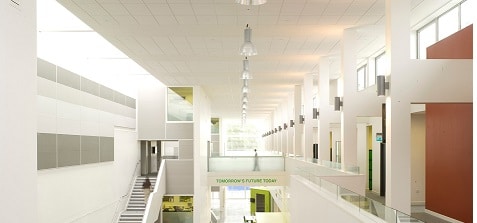The Gypsum Products Development Association (GPDA) is highlighting the role of gypsum-based plasters and plasterboard in the trend towards building for ‘wellbeing’ in interiors.
According to the GPDA, which represents Britain and Ireland’s gypsum product manufacturers, plasterboard and plaster scores highly on many key design factors identified by Evidence Based Design (EBD), from good sound and thermal insulation to improved air quality and aesthetics, all of which can add value to the physical environment and promote human wellbeing.
 Scientific research related to human behaviour in a built environment indicates that design factors such as colour, acoustics, lighting and furnishings have a calculable impact on building occupants. EBD is used by architects and interior designers to make design decisions based on this research and associated evidence. Creating a ‘feel good’ environment can have a positive impact on building users, whilst in a business environment it can lead to reduced stress, increased job satisfaction and productivity.
Scientific research related to human behaviour in a built environment indicates that design factors such as colour, acoustics, lighting and furnishings have a calculable impact on building occupants. EBD is used by architects and interior designers to make design decisions based on this research and associated evidence. Creating a ‘feel good’ environment can have a positive impact on building users, whilst in a business environment it can lead to reduced stress, increased job satisfaction and productivity.
As well as offering quick, easy and cost-effective drywall solutions, the GPDA believes the all-round performance properties of modern gypsum-based products and systems can contribute to wellbeing in interiors. On the subject of noise, for example, gypsum wall, ceiling and floor systems can create beneficial quiet zones and can be designed to provide a physical barrier to sound, incorporate a sound break and minimise reverberation.
Thanks to low thermal conductivity, gypsum plasterboards systems, together with an insulating material, can contribute significantly to the thermal performance of external walls and linings. This helps to maintain a comfortable room temperature for building occupants – both warm in winter and cool in summer.
Gypsum plaster and plasterboards also have a useful ‘heat storing’ ability : small temperature increases are absorbed and radiated back when the temperature in the room decreases. In addition, gypsum can improve air quality as it is capable of ‘storing’ humidity when a room is humid and automatically releasing this humidity if the indoor air becomes too dry. As well as their technical performance, gypsum-based plasterboards can enhance the interior aesthetic, including flexible boards for creating attractive curved walls and ceilings and drywall solutions with a choice of smooth or textured finish to complement the interior design.
Already accepted in healthcare architecture, where it has demonstrated positive effects on patients, staff and clinical outcomes, EDB could now bring long term benefits to other sectors, suggests GPDA Secretary, Crispin Dunn-Meynell. “Our member-manufacturers support the greater awareness of EBD within the construction industry,” he comments. “Wellbeing in interiors has been largely subsumed over the last decade in the welter of information about sustainability, particularly energy consumption, often at the expense of beneficial outcomes for building owners and occupants, but the trend is now increasingly moving toward considering other aspects.
Crispin Dunn-Meynell concluded: “Given the proven benefits in healthcare buildings, we believe there is a need to examine how EBD could be applied more widely. By adopting this research-based approach to interior design in, for example, places of work, schools and even homes, the industry has an opportunity to increase and sustain wellbeing for all, while creating interiors that people want to occupy.”
The GPDA represents the four major gypsum board and plaster manufacturers: British Gypsum, Siniat, and Knauf in Britain, and Gypsum Industries in Ireland.


